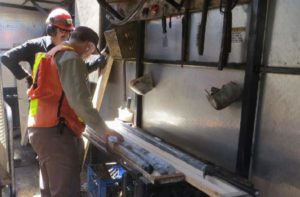Marathon’s deep drilling cuts 5.0 metres of 11.08 g/t gold at Valentine Lake

Logging diamond drill core at Marathon Gold's Valentine Lake Gold Camp on the Island of Newfoundland. Source: Marathon Gold Corp.

Marathon Gold Corp. [TSX-MOZ] reported high-grade gold assays through thick intervals of stacked quartz-tourmaline-pyrite (QTP) veining with visible gold in drill holes MA-17-174 and MA-17-175, the deepest holes ever drilled at the Marathon Deposit on its 100%-owned Valentine Lake Gold Camp on the Island of Newfoundland.
These sub-vertical holes, spaced 180 metres apart along strike, were drilled down through the mineralized corridor of the Marathon Deposit and both intersected abundant, wide intervals of QTP veining with numerous occurrences of visible gold (VG) at depths of up to 950 metres. As a result of drilling from 2014 to date, the uniformity of mineralization in the Marathon Deposit, encountered both at depth and along strike, is indicative of an extensive and strong mineralizing system.
Drill hole MA-17-175 intersected wide intervals of intermittent moderate to high-grade gold to depths of 966 metres, including 1.77 g/t gold over 101 metres with 6.48 g/t gold over 7 meters and 7.92 g/t gold over 4.0 metres, 4.09 g/t gold over 19.0 metres with 12.54 g/t gold over 5 metres and 3.25 g/t gold over 32.0 metres with 11.08 g/t over 5.0 meters.
Drill hole MA-17-174 continued to return significant intermittently spaced gold intervals to a depth of 782 metres along the hanging wall edge of the mineralized corridor. The deeper intervals included 3.05 g/t gold over 3.0 metres, 6.65 g/t gold over 3.0 metres and 3.31 g/t gold over 3.0 metres. Both of these deep drill holes clearly demonstrate the potential for definition of additional gold resources beneath the lower limit of the February 2017 resource body..
The Marathon Deposit is a classic orogenic gold deposit that is found throughout the world which has produced the majority of the world’s gold. The Timmins and Val d’Or orogenic-type gold deposits are noted for having gold deposited at more than 2 km in depth, which gives them great underground mining potential. Marathon management sees the same underground mining potential at the Marathon Deposit.
Highlights:
- Best intercepts in MA-17-174 included 1.36 g/t gold over 76.0 metres with 3.37 g/t gold over 20.0 metres as well as deeper intercepts of 3.05 g/t gold over 3.0 metres, 6.65 g/t gold over 3.0 metres and 3.31 g/t gold over 3.0 metres.
- Best intercepts in MA-17-175 included 1.77 g/t gold over 101.0 metres with 6.48 g/t gold over 7.0 metres and 7.92 g/t gold over 4.0 metres, 4.09 g/t gold over 19.0 metres with 12.54 g/t gold over 5 metres and 3.25 g/t gold over 32.0 metres with 11.08 g/t over 5.0 metres.
The two drill holes intersected numerous narrow, high-grade zones at depth separated by lower grade material. The extensive nature of this mineralization on the hanging wall of the mineralized corridor suggests that there may be better mineralization towards the center of the corridor and that will require additional drilling to prove up.
Drill holes MA-17-176, MA-17-178 and MA-17-179 were designed to pass through the mineralized corridor at higher elevations than MA-17-174 and MA-17-175 and have successfully encountered typical QTP veins with VG. Assays for these three holes are pending.
“The results of the deep exploration drilling of MA-17-174 and MA-17-175 are very exciting. The potential for deep gold mineralization has been clearly demonstrated. The stage is set for exploring to depth for underground resources and additional open pit resources at the Marathon Deposit. Our goal for the next phase of drilling is to rapidly develop these resources by following the 40 to 100 meter wide mineralized corridor of gold mineralization, which is open along strike in both directions, and also extends to at least 1000 meters in depth and possibly more,” said Phillip Walford, President and CEO. See company press release for compete assays and figures.
The Valentine Lake property currently hosts four near-surface, mainly pit-shell constrained, gold resources totaling 1,388,200 oz gold at 1.91 g/t (measured & indicated) and 766,500 oz gold at 2.24 g/t (inferred), (February 2017).
Drilling in 2017 will continue to focus on expanding the Marathon Deposit at surface and to depth. The property is accessible by year-round round, and is located within Newfoundland’s electrical grid. The company has constructed and maintains a 50-person all-season camp at the project. Recent metallurgical tests have demonstrated 93% to 98% recoveries via conventional milling and 50% to 70% recoveries via low cost heap leaching at both the Leprechaun and Marathon Deposits.
